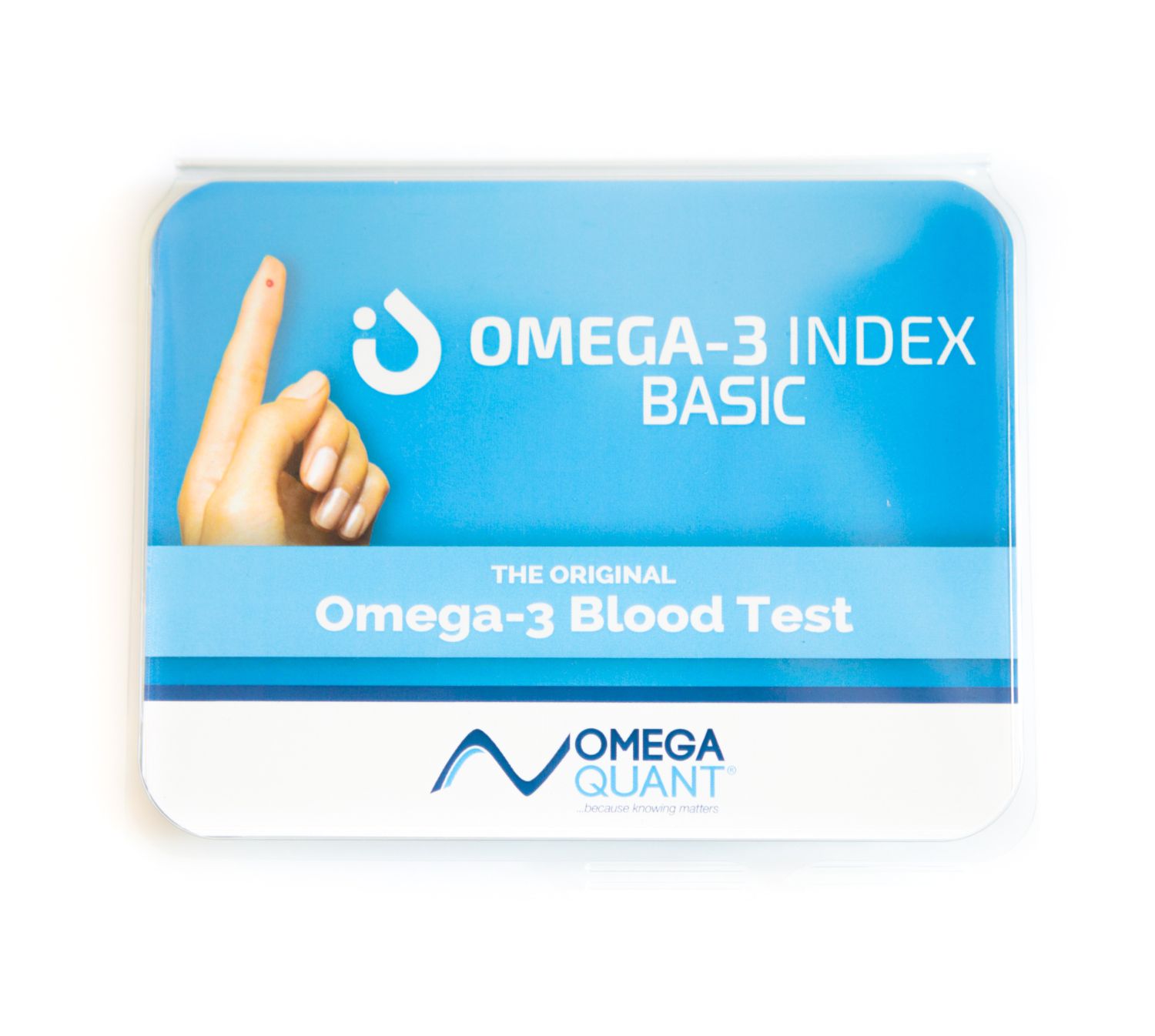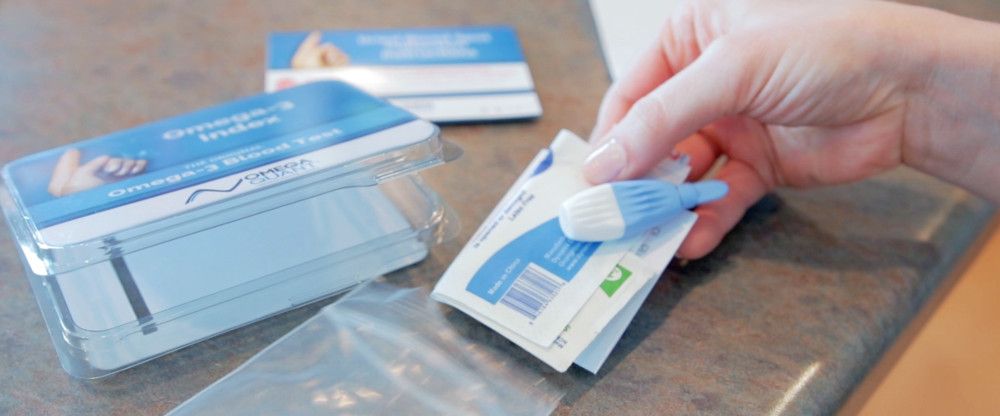Nutritional Outlook’s 2019 Best of the Industry Awards, Retail Brand/Product: OmegaQuant
OmegaQuant is giving consumers a way to measure omega-3 content-and a reason to take supplements.
Photos from OmegaQuant

The omega-3 category has had its highs and lows over the years. Occasional bad press has hurt public opinion about the benefits of omega-3 EPA and DHA supplements, affecting sales, but the category always seems to bounce back. That’s probably because omega-3s remain among the most well researched and recognized nutrients on the market. Over 4,000 studies have demonstrated the role of EPA and DHA in the health of our heart, eyes, and brain, as well as the healthy development of fetuses and children in utero and after birth.1
One company working to keep omega-3s at the forefront of consumer attention is OmegaQuant, based in Sioux Falls, SD. The company provides simple at-home kits for consumers to test their Omega-3 Index-a measure of the level of omega-3 EPA and DHA fatty acids in red blood cells. This Index number can help to indicate one’s risk for cardiovascular disease and allows people to take preventative action by either eating more fish and foods rich in omega-3 fatty acids or taking omega-3 dietary supplements. OmegaQuant’s kits provide users with everything they need to administer testing. Via a simple finger stick, consumers send back a drop of blood for analysis. OmegaQuant also provides fatty acid analytical services for researchers.
More than 200 clinical studies have utilized the Omega-3 Index methodology, and OmegaQuant continues to study the Omega-3 Index and build its library of research validating the role of omega-3s in our health, especially cardiovascular health. By providing this reliable scientific metric for gauging omega-3 status as it relates to heart health, OmegaQuant is empowering consumers and giving dietary supplement brands the ability to more effectively market their products. That is why OmegaQuant is recognized as the Best of the Industry this year.
Planting the Seed
The turn of the 21st century was a very important moment for omega-3 research. In 1999, the landmark GISSI-Prevenzione trial found omega-3 supplementation significantly reduced the risk of death, cardiovascular death, non-fatal myocardial infarction, and stroke.2 In 2002, expanded analysis of the study results showed just how fast omega-3s’ effects occurred (in as little as three months) and hypothesized that the effects were due to a reduced risk of arrhythmia.3 Meanwhile, confronted with the recent revelations about omega-3s and heart health, William S. Harris, PhD, president and CEO of OmegaQuant, and his colleague, a German cardiologist named Clemens von Schacky, MD, pondered whether omega-3 EPA and DHA levels in the blood could be a risk factor for sudden cardiac death.

In 2004, Harris and von Schacky published a paper proposing that a person’s Omega-3 Index can be a new means of measuring the risk of cardiovascular death.4 More specifically, the paper posits that the fatty acid composition of red blood cells, dubbed the Omega-3 Index, reflects long-term intakes of omega-3 EPA and DHA and can indicate risk of coronary heart disease death. They concluded that an Omega-3 Index of greater than 8% was associated with the greatest cardioprotection, while an index less than 4% was associated with the least.
The immediate response to the article was “exceedingly quiet,” says Harris, but this eventually changed. “It was like a seed planted in a field that only slowly began to emerge from the dirt and grow and grow,” he says. “I think the watershed event for the test was probably our first publication using the test in the Framingham Cohort5. Being associated with that well-respected study gave it more legitimacy than anything we’d done before.”
Since then, the Omega-3 Index has been making its way into more and more research. “The logic of the red blood cell membrane serving as a repository for EPA and DHA and thus a marker for omega-3 status of other tissues has been compelling,” says Harris. He explains that omega-3 EPA and DHA levels in red blood cells remain more stable over time compared to plasma-based samples. “Plasma levels can go up immediately after a big salmon meal, but red blood cell levels don’t. In other words, the red blood cell is not artificially influenced by a one-time load of omega-3, while plasma is.”
This makes the Omega-3 Index a better long-term measure of omega-3 status. Harris compares it to HbA1c testing for diabetes, which is preferred to plasma glucose testing. This is because HbA1c is red blood cell–based and a much more stable long-term marker of glucose status than plasma glucose, which can fluctuate.
The challenge remains to get broader acceptance of the Omega-3 Index from physicians. “Detractors [of the Omega-3 Index] are typically physicians who are not experts in the field who read only headlines of studies and who think there’s nothing to the omega-3 story,” says Harris. “They obviously see no value in measuring omega-3 status. If they knew that the Omega-3 Index is considered a superior marker of risk for heart disease and death than cholesterol, they might change their minds.”
That’s true. A study published in Lipid Journal found that in a head-to-head comparison between the Omega-3 Index and total cholesterol as a predictor of cardiovascular disease and mortality, the Omega-3 Index was significantly associated with total cardiovascular disease, coronary heart disease, and any mortality, while cholesterol was not significantly associated with any of these.6
This is why OmegaQuant exists, Harris says. It gives people greater control and knowledge of their own health. “We realized that the medical community was going to be slow to take up the Omega-3 Index test, and that insurance companies-because it’s ‘new’-would not be paying for it,” says Harris. “The movement toward self-healthcare and personalized nutrition also pointed us to consumers.”

Most recently, OmegaQuant launched its Prenatal DHA Test, allowing expecting mothers to monitor their omega-3 DHA level, which has a profound effect on the development of the baby before and after birth. Recent research has found that supplementation with omega-3s is associated with a significantly reduced risk of preterm birth. One Cochrane meta-analysis of 70 randomized controlled trials found that preterm birth (<37 weeks gestation) and very preterm birth (<34 weeks gestation) were reduced by 11% and 42%, respectively, when women took omega-3 supplements.7
Another study found the risk of early preterm birth was ten times higher among women with an EPA and DHA omega-3 concentration less than 1.6% of total blood plasma.8 Using this data, OmegaQuant converted EPA and DHA plasma levels to red blood cell DHA levels and determined that pregnant women would need at least 5% DHA content in red blood cells to prevent early preterm birth. In a proposal of this prenatal DHA test published in Nutrients, Harris and OmegaQuant’s research associate, Kristina Harris Jackson, PhD, RD, determined that 70% of women of childbearing age are below the 5% DHA cutoff.9
OmegaQuant is also giving researchers a more reliable way to study omega-3 supplementation with its recently devised Omega-3 Calculator. The Omega-3 Calculator is an attempt to model the effects of omega-3 supplementation on the Omega-3 Index. In a study published in The American Journal of Clinical Nutrition, Harris and Jackson, along with other researchers, created a model equation that estimated the final Omega-3 Index of a population based on the dosage of omega-3 EPA and DHA and baseline Omega-3 Index.10
For example, a population with a baseline Omega-3 Index of 4.9% that is given 840 mg EPA and DHA per day for 13 weeks, as a 1-g ethyl ester capsule, would reach an Omega-3 Index of about 6.5%. Using this equation, one can also calculate the approximate dosage necessary to achieve a mean Omega-3 Index of 8% in 13 weeks. According to the study, for a population with a baseline Omega-3 Index of 2%, 2200 mg of EPA and DHA is required, while for those with a baseline Omega-3 Index of 4% and 6%, 1500 mg and 750 mg of EPA and DHA is required, respectively.11
“[The Omega-3 Calculator] makes it easier for researchers to select a dose that will give them a cardioprotective Omega-3 Index. The old way was just to give one capsule and see what happens (or doesn’t happen!), without any concern for the right dose,” explains Harris. “The calculator, imperfect as it may be because of unknown factors that cause the Omega-3 Index response to fish oil supplementation to vary from person to person, really should be used for groups, not individuals.”
The Word Is Out
When OmegaQuant launched in 2009, the science behind the Omega-3 Index test was well-established, but getting the Omega-3 Index tests in the hands of consumers was the real challenge, says Harris. “Implementing the logistics was not difficult; the difficulty was in marketing and education,” he says. “We’ve done a lot of free testing at meetings and for ‘influencers’ over the years, and will no doubt keep that up.”
The Omega-3 Index can also be an invaluable tool for finished product manufacturers. For example, supplements brand MegaRed recently did a campaign that tested the Omega-3 Index of 234 individuals in and around Newport, RI, a coastal city with easy access to seafood. Results showed that the 96% of Newport-area residents were below the target Omega-3 Index range of 8%, with an average score of 5.2%. The campaign highlighted the importance of supplementation even for those who live in a place where seafood consumption is an everyday part of life.
The word is out, apparently. Inc. magazine recently recognized the company in its 2019 Inc. 5000 list, ranking OmegaQuant at #2271.12 According to Inc., the company has grown 177% in three years. One can only hope that OmegaQuant’s continued growth reflects greater consumer awareness of the benefits of omega-3 supplementation and the importance of the Omega-3 Index.
References:
- Decker KJ. “Omega-3 market in 2019.” Nutritional Outlook, vol. 22, no. 7 (September 2019): 86-90. Accessed at: www.nutritionaloutlook.com/article/omega-3-market-2019
- “Dietary supplementation with n-3 polyunsaturated fatty acids and vitamin E after myocardial infarction: results of the GISSI-Prevenzione trial. Gruppo Italiano per lo Studio della Sopravvivenza nell’Infarto miocardico.” The Lancet, vol. 354, no. 9177 (August 7, 1999): 447-455
- Marchioli R et al. “Early protection against sudden death by n-3 polyunsaturated fatty acids after myocardial infarction: time-course analysis of the results of the Gruppo Italiano per lo Studio della Sopravvivenza nell’Infarto Miocardico (GISSI)-Prevenzione.” Circulation, vol. 105, no. 16 (April 23, 2002): 1897-1903
- Harris WS et al. “The Omega-3 Index: a new risk factor for death from coronary heart disease?” Preventative Medicine, vol. 39, no. 1 (July 2004): 212-220
- Harris WS et al. “Changes in erythrocyte membrane trans and marine fatty acids between 1999 and 2006 in older Americans.” The Journal of Nutrition, vol. 142, no. 7 (July 2012): 1297-1303
- Harris WS et al. “Erythrocyte long-chain omega-3 fatty acid levels are inversely associated with mortality and with incident cardiovascular disease: The Framingham Heart Study.” Journal of Clinical Lipidology, vol. 12, no. 3 (May-June 2018): 718-727
- Middleton P et al. “Omega-3 fatty acid addition during pregnancy.” Cochrane Database of Systematic Reviews. Published online November 15, 2018.
- Olsen SF et al. “Plasma concentrations of long chain omega-3 fatty acids in early and mid-pregnancy and risk of early preterm birth.” EBioMedicine, vol. 35 (September 2018): 325-333
- Jackson KH et al. “A prenatal DHA test to help identify women at increased risk for early preterm birth: a proposal.” Nutrients, vol. 10, no. 12 (December 6, 2018): 1933
- Walker RE et al. “Predicting the effects of supplemental EPA and DHA on the omega-3 index.” The American Journal of Clinical Nutrition, vol. 110, no. 4, (October 1, 2019): 1034-1040
- Krawiec S. “Recent study devises ‘omega-3 calculator’ to help researcher determine proper EPA and DHA doses.” Nutritional Outlook. Published on August 28, 2019. Accessed at: www.nutritionaloutlook.com/omega-3/recent-study-devises-omega-3-calculator-help-researcher-determine-proper-epa-and-dha-doses
- 2019 Inc. 5000 Ranking. Accessed at: www.inc.com/profile/omegaquant

Prinova acquires Aplinova to further increase its footprint in Latin America
April 7th 2025Prinova has recently announced the acquisition of Brazilian ingredients distributor Aplinova, which is a provider of specialty ingredients for a range of market segments that include food, beverage, supplements, and personal care.


















